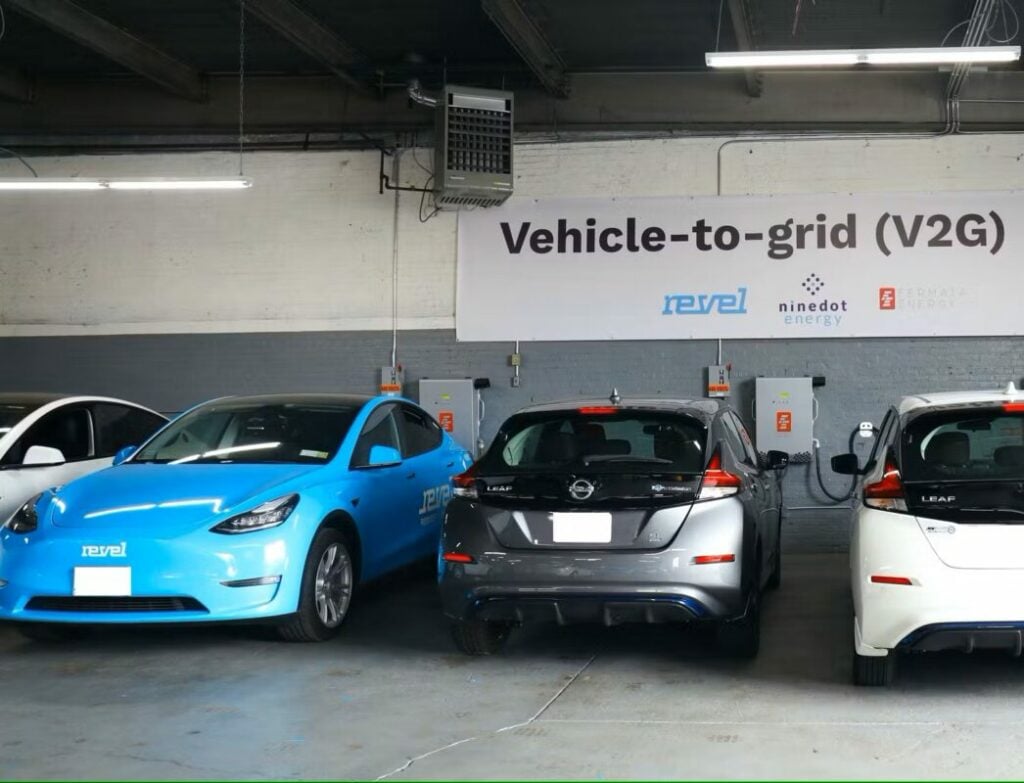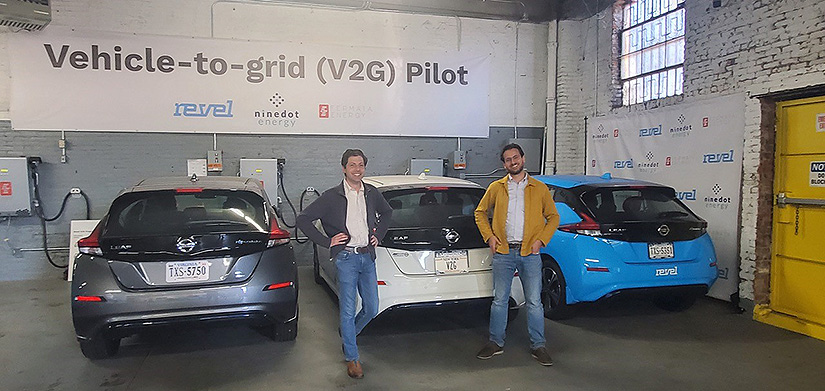
New York City’s first-ever vehicle-to-grid (V2G) pilot project is entering a second stage of development, following a successful start to its operational life. Part of the tenth cohort of the Wells Fargo Innovation Incubator (IN2), and with technical assistance from the US National Renewable Energy Laboratory (NREL), the project has been carried out by New York-headquartered energy storage developer Ninedot Energy.
It was funded by IN2 to demonstrate V2G applications in New York City, and became operational in the late summer of 2022. Hosted at a Brooklyn garage belonging to Revel, an all-electric ride hailing service provider, the hardware and software technology was provided by bidirectional charging equipment specialist Fermata.
Enjoy 12 months of exclusive analysis
- Regular insight and analysis of the industry’s biggest developments
- In-depth interviews with the industry’s leading figures
- Annual digital subscription to the PV Tech Power journal
- Discounts on Solar Media’s portfolio of events, in-person and virtual
“We developed it and procured the chargers and worked with Revel to install them at their garage, and deployed three Nissan LEAFs to test out these capabilities [and] kind of proved that we could interconnect the bidirectional chargers with the utility, export power effectively and monetise that,” Joe Silver, senior product manager at Ninedot says.
The developer is now working with NREL and its experts to analyse the results and figure out ways to scale up the technology and better interface with utilities, Silver says. At the same time, learnings from the project are already giving Ninedot a platform to develop further V2G projects around city.
Taking advantage of the value stack
Key to Ninedot’s development of the different use cases and applications the energy stored in the electric vehicles (EVs) provides is the New York programme Value of Distributed Energy Resources (VDER).
Sometimes referred to as the ‘Value Stack’, VDER compensates different distributed energy resource (DER) assets, such as rooftop solar and community battery storage, for the value they create. As regular readers of Energy-Storage.news may know, as a developer of distributed storage assets with a major focus on New York, Ninedot was already familiar with VDER and how it works before embarking on the V2G pilot.
Designed and implemented by New York State’s regulatory Public Service Commission (PSC), Value Stack compensation is paid out in the form of bill credits to projects based on where and when they provide electricity to the grid.
There are five ‘layers’ to the Value Stack: energy value, capacity value, environmental value, demand reduction value and locational system relief value.
Three of those parts are valuable for energy storage, Silver says: capacity value, demand reduction value and locational system relief value – analogous to locational marginal pricing – which formed the basis for the pilot.
VDER incentivises “to export as much as you can,” and with New York City’s electricity demand management challenges largely focused around summertime peaks, that equates to about “60 weekday, non-holidays in the summer,” according to the developer.
As the project came online in August 2022, it had already missed roughly half of that summer’s applicable peak periods, meaning that 2023 marked the first summer of full operation, and it was a successful one in proving out the technical feasibility of V2G and that it could be used within the parameters of utility programmes.
The major upside of VDER is that it is technology agnostic, Silver says, and it is “really valuing the electricity that’s being exported” and electric vehicles are eligible in the same manner as Ninedot’s stationary storage system projects.
Data evaluation finds ‘Golden Spots’ for charger installation
NREL’s data evaluation role in the project is around making sure the value of V2G is properly assessed and understood. The lab has been developing software that helps identify effective sites to install charging stations and to identify the time periods during which the parked Nissans will be doing V2G power export, says Harsha Vardhana Padullaparti, an NREL researcher participating in the project.
The tool takes a given distribution grid model and then uses the utility’s tariff structure – including composition, factors in local EV ownership characteristics, charging station profiles and characteristics – and determines where to best place charging units, the so-called ‘Golden Spots,’ Vardhana Padullaparti says.
It also computes all of the costs involved, and expected revenues from operations, including V2G.
“One key observation from this analysis was that the revenue usually – taking the substation as a reference point – the further we go away from a substation, the revenue tends to be higher,” Vardhana Padullaparti says.
“That’s because, as we go further down from the substation, the voltage tends to be lower, which means there is a more headroom to inject more power into the grid. If it is closer to the substation, usually the voltage is already higher and if we inject more power into the grid, then it hits the voltage upper limit, but this is not a universal case. If the service transformer capacity is high, then usually there is more headroom to export the power to the grid. That means that gives the charging operator more revenue,” the researcher says.
Commercial-scale questions
However, the VDER programme itself could ultimately be limiting of the economic case for V2G at scale, Ninedot’s Silver notes, due to that major focus on the summer peak days.
“For more commercial scale, and maybe other applications, it’s not always ideal, and you will always guarantee a fleet of vehicles available every weekday non-holiday in the summer.”
For Ninedot’s distributed energy storage projects elsewhere in New York, the developer doesn’t just leverage VDER, it also enrols them in demand response programmes, which it hasn’t done for the V2G trial.
Demand response programmes might have somewhere between five and ten export events over a summer, on which participants will be given notice, and will be able to predict.
As we saw last year in an article in our quarterly journal PV Tech Power (Vol.33), which looked at three V2G/V2X projects designed to assess and address barriers to adoption, one of the main challenges with V2G is in ensuring the batteries’ owners don’t need to be using them at the same time they’re wanted for delivering grid services.

The three case studies from that article all looked at V2G operators using fleet vehicles, an approach that resonates with Ninedot’s. Silver says any fleet with predictable usage that can be planned around is therefore a potential candidate. The obvious choice is school buses: with New York State mandating that all school buses are electric by 2035, “everybody’s talking about using these vehicles that are mostly parked all summer long,” he says.
An interesting aspect of V2G in the New York City context specifically is that state and city-level legislature and regulations mean EVs are allowed to be installed and used in New York in ways that “not all batteries, stationary batteries, are”. The city has some of the world’s most stringent fire codes and an ongoing debate around safe lithium-ion battery use, a “key tailwind” and a positive for the business case.
From a permitting perspective that makes V2G potentially very attractive, and perhaps even a unique opportunity for NYC that has only just begun to be explored.
One other aspect regular readers of Energy-Storage.news will likely be aware of is that New York State is targeting the deployment of 6GW of energy storage by 2030, from an installed base of a few hundred megawatts today.
While the bulk of that will comprise large-scale energy storage facilities owned or contracted for by investor-owned utilities (IOUs), there will also be a significant portion which will come from distributed storage resources. We have seen that the state has faced a slow start in addressing that target, including its IOUs like Con Edison, the service area of which the Ninedot-Fermata-Revel trial is located.
‘Serious revenue streams’
As the cost of birectional chargers continues to come down, and become more price competitive with DC fast chargers, if not with slower Level 2 EV charging equipment, V2G could become a meaningful source of revenues. This is true not only in terms of covering the incremental cost of the charging equipment, but also providing EV fleet operators with “serious new revenue streams and reducing the operations costs of their fleets,” Silver says.
“One thing that a lot of these fleets are dealing with is this new line item on their operations, which is this electricity bill that they have not really dealt with in the past,” he says.
“They understand fuel contracts and getting good supplies, maybe of diesel or gas, but this is a whole new world for them and making sure they’re getting a good deal on that and making sure that they are reducing those costs as much as possible because the whole one of the stated benefits of electrification is lowering that Opex but in practice, without the right demand management or programme participation, that can go in the other direction.”
With the ongoing wave of electrification of transport, thousands of plugs of various kinds are being installed all over New York City, representing a “massive” amount of load that the grid needs to deal with.
“We can argue that well placed bidirectional chargers within that portfolio can turn EV chargers from a liability into a great asset,” Silver says.
“Doing that effectively requires the developer community, the charging station community, the fleet operators, the researchers like NREL, the software companies, to kind of work together and go beyond these pilots into real commercial operations. So that’s what we’re trying to do. We see a massive potential, but it is definitely still early days.”
Energy-Storage.news’ publisher Solar Media will host the 6th Energy Storage Summit USA, 19-20 March 2024 in Austin, Texas. Featuring a packed programme of panels, presentations and fireside chats from industry leaders focusing on accelerating the market for energy storage across the country. For more information, go to the website.

